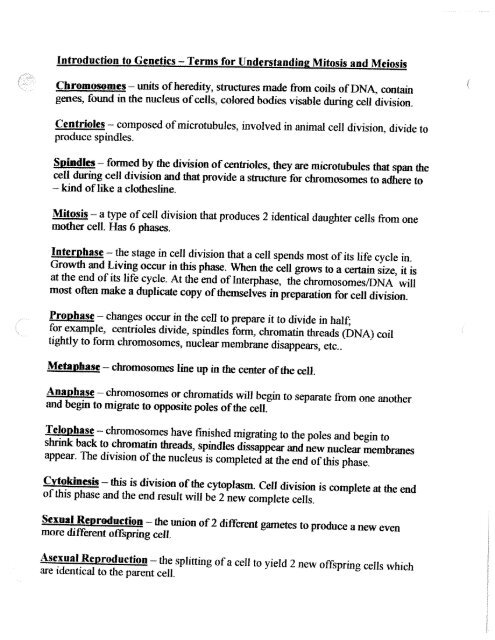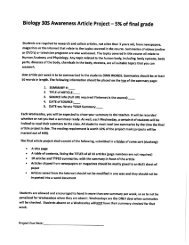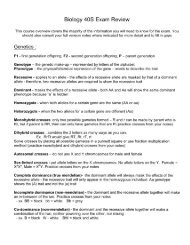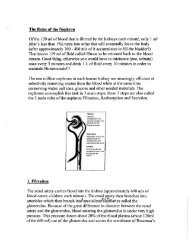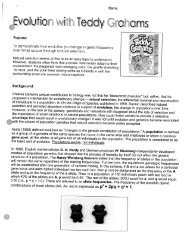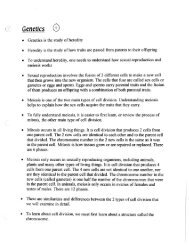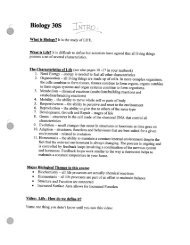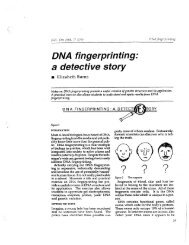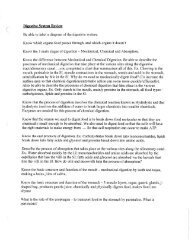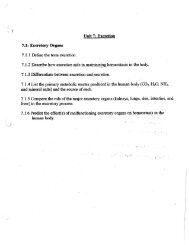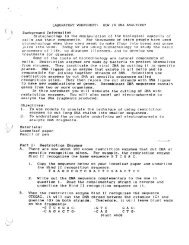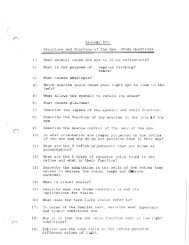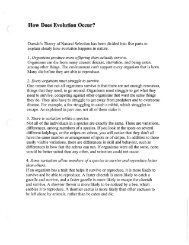Genetic Terms (1 page).pdf - Mrs Stovel
Genetic Terms (1 page).pdf - Mrs Stovel
Genetic Terms (1 page).pdf - Mrs Stovel
Create successful ePaper yourself
Turn your PDF publications into a flip-book with our unique Google optimized e-Paper software.
Introduction to <strong>Genetic</strong>s - <strong>Terms</strong> for Understandin g Mitosis and MeiosisChromosomes - units of heredity, structures made from coils of DNA, containgenes, found in the nucleus of cells, colored bodies visabie during cell division.Centrioles - composed of microtubules, involved in animal cell division, divide toproduce spindles.Spindles - formed by the division of centrioles, they are microtubules that span thecell during cell division and that provide a structure for chromosomes to adhere to- kind of like a clothesline.Mitosis - a type of cell division that produces 2 identical daughter cells from onemother cell. Has 6 phases.Tnterphase - the stage in cell division that a cell spends most of its life cycle in.Growth and Living occur in this phase. When the cell grows to a certain size, it isat the end of its life cycle. At the end of Interphase, the chromosomes/DNA willmost often make a duplicate copy of themselves in preparation for cell division.Prophase -- changes occur in the cell to prepare it to divide in half;for example, centrioles divide, spindles form, chromatin threads (DNA) coiltightly to form chromosomes, nuclear membrane disappears, etc..Metaphase - chromosomes line up in the center of the cell.Anaphase - chromosomes or chromatids will begin to separate from one anotherand begin to migrate to opposite poles of the cell.Telophase - chromosomes have finished migrating to the poles and begin toshrink back to chromatin threads, spindles dissappear and new nuclear membranesappear. The division of the nucleus is completed at the end of this phase.Cytokinesi s - this is division of the cytoplasm. Cell division is complete at the endof this phase and the end result will be 2 new complete cells.Sexual Reproduction - the union of 2 different gametes to produce a new evenmore different offspring cell.Asexual Reproduction - the splitting of a cell to yield 2 new offspring cells whichare identical to the parent cell.
Gametes - cells with half of the species chromosome number which will uniteduring sexual reproduction.Zygote -- the new cell that results when a male gamete (sperm) fuses with a femalegamete (egg)-Meiosis - a type of cell division that produces gametes. The gametes producedhave one half of the parent cell's chromosome #. Because the chromosome numberis halved after this type of cell division, meiosis is sometimes called "reductiondivision". One parent cell produces 4 non-identical daughter cells. 12 phases (twotimes the 6 phases of mitosis with a few differences; homologous pairing inmetaphase I and no chromosome doubling in Interphase ii).Ham--- refers to a cell that contains one half of the species chromosome #.Diploid - refers to a cell that contains the full species chromosome # - that is, 2complete sets of chromosomes - one maternal set and one paternal set.Homologous chromosomes - are chromosomes that are of similar length andcontain similar genetic information. These chromosomes form tetrads duringmeiosis and may engage in one or more cross over events.Independent Assortment - when chromosomes line up in the center of the cellduring metaphase, they do so at random - i.e. the chromosomes assort themselvesindependently in the center.Crossing over - when homologous chromosomes form tetrads, they can toucheach other, break off and swap chromosomes to re-attach to.Kinetochore - a microtubule structure that "pins" a chromosome to the spindlefiber during cell division.Centromere - the button-like structure in the middle of a chromosome that holds 2sister chromatids together.Chiasmata - the spot where homologous chromosomes touch each other if theyengage in synapsis.Synapsis - the closing of the gap between homologous chromosomes due to themtouching or crossing over,


